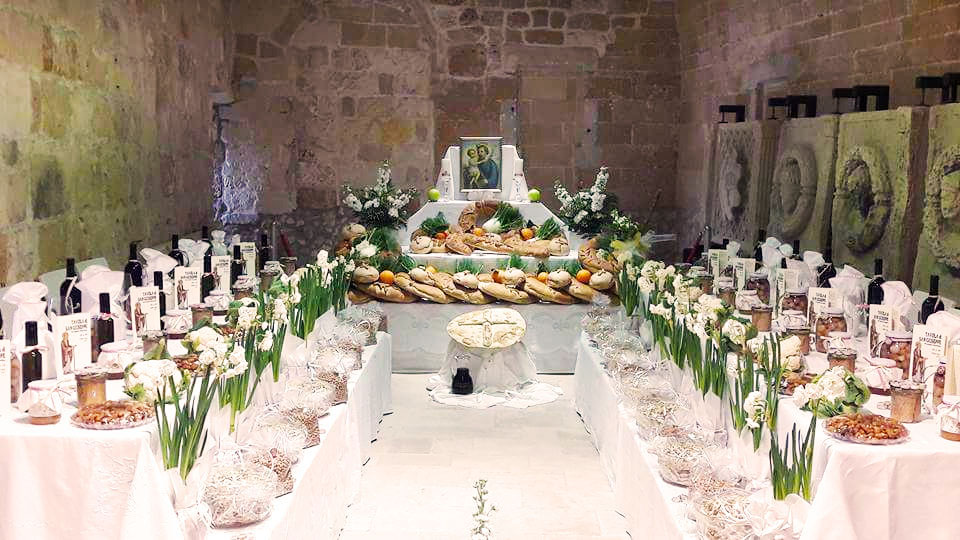On March 19, the feast of St. Joseph is celebrated by Catholics world-wide, but by varying degrees. In Italy and especially Sicily, the roots of this day go back to the Middle Ages and the beloved step-father of Jesus is honored with an age-old tradition called Tavola di San Giuseppe – St. Joseph’s Table.
The St. Joseph tradition first came about during the Middle Ages in Sicily, when a severe drought plagued the island, resulting in widespread famine. Fearing the worst, the Sicilians prayed to Saint Joseph, the Patron Saint of fathers, carpenters and Sicily and their prayers were answered. The rains came and the drought receded. To thank and honor St. Joseph, the wealthier villagers created a great feast of meatless foods, since it was during the Lenten season, for all to enjoy, but especially the poor. In the finest Italian heritage, homage to St. Joseph continues in the form of food and celebration. In some villages, the people also hold a great public play and procession.
The first St. Joseph Table set up on the Island of Sicily was a small one. Many of the dishes contained fish and fava beans, a Sicilian crop of immense importance. Over the years, many different types of foods have joined the traditional ones at La Tavola di San Giuseppe and all are brought in with the theme of bounty food for all.
At a traditional Tavola di San Giuseppe, it is filled with food brought by parishioners from local churches. Everyone in attendance should sample at least one dish that has bread, since it is a symbol of luck and at least one dish that has fava beans, the symbol of health. The fava bean is strongly tied to the Feast Day. Originally, the fava bean had a poor reputation among foods. It was most commonly used as animal feed, leading to such alternate informal names as horse beans and pigeon beans. The rise in stature of the fava bean began during the famine in Sicily. Perhaps inspired by St. Joseph, farmers in Sicily had their wives prepare the fava beans for the table. This ingenuity helped to save many from starvation and since then the beans have been considered to be lucky. The bean is also a symbol of fertility since it grows well, even in poor or rocky soil. Italian farmers would carry a bean from a good crop to ensure a good crop the following year. When dried, roasted and blessed, it becomes the very popular lucky bean. Legend has it that you will never be penniless as long as you carry one. Some people believe that if you keep one in the pantry, there will always be food in the kitchen.
On the St. Joseph’s Day Altar, it is also customary to place candles, flowers and wine, along with lemons and limes, fava beans, cakes, breads, cookies and a custard-filled dough ball known as fritelle in Rome and Florence, zeppole in Naples and Puglia and sfingi in Sicily. The sweets can be fried or baked and are a delicious, slightly indulgent way to celebrate the Feast of St. Joseph. A lesser known attribute of St. Joseph is that he is the patron saint of pastry chefs.
Foods are traditionally served containing bread crumbs, which resemble saw dust, representing St. Joseph’s occupation as a carpenter. Since no meat is allowed on the celebration table, seafood dishes are served – shrimp, calamari and sardines being predominant. Additionally, the table or altar usually has three tiers to represent the Holy Trinity.
Just before the feasting begins, there will be a cry of, “Viva la tavola di San Giuse!” an expression repeated throughout the day. When the feasting has ended, the St. Joseph’s Table is disassembled and three children dressed as the Holy Family will knock on three doors, asking for shelter. They will be refused shelter at the first two and welcomed at the third, in memory of the Holy Family’s seeking of hospitality just before Christ was born. This charming re-enactment is called Tupa Tupa, meaning Knock Knock.
At the end of the day everyone takes home a bag filled with bread or pastries, a medal of St. Joseph and a blessed fava bean. Lemons, like fava beans, are reputed to bring good luck. One of the most curious customs is for a woman who is seeking a husband to inconspicuously take a lemon from the altar, since it will help them to find a husband.
In Sicily, a Tavola di San Giuseppe or the Table of Saint Joseph, is set up on the evening of March 18th. The table is laden with food and it is customary for residents to invite the poor into their homes to eat, as homeless people are made welcome at the table on this day.
While the most common way to celebrate St. Joseph’s Day in southern Italy is with a Tavola di San Giuseppe, northerners mark the holiday with bonfires that burn brightly through the night. In the Valley of the Trebbia River between Emilia-Romagna and Liguria, fires are often lit in celebration of Saint Joseph and to commemorate the beginning of spring. An effigy representing winter is burned at the vernal equinox at these bonfires, a remnant of the ancient pagan ritual dating back to the 6th century BC. Today, on the evening of March 19, it is said that the whole countryside is blushed with a rosy hew in the night air, as each hilltop wears a ‘crown of flame.’
The Fuocarone or Great Fire of St. Joseph is an ancient tradition that takes place in Villa Basilica in Tuscany. Weeks before the festival, the men of the village venture into the forest in search of a pine tree with the right characteristics. Branches are removed from the tree’s trunk to create poles, which are then placed upright in the town square and are used as a stake to build a towering bonfire as high as 15 feet. While no specific food or drink is particular to the festival, it is a great chance for the community to socialize as they celebrate St. Joseph’s Day and prepare for spring.
This practice can also be found in Itri, in the region of Lazio, where up to two months before the feast, young boys are accompanied by adults into the woods to retrieve young oak saplings which are dried and used for the bonfire.
Though many cities have their own way of marking this holiday, Italians everywhere use this day to show their gratitude to their fathers. While America celebrates Father’s Day in the month of June, Italians honor their dads on the March 19 to commemorate San Giuseppe – the patron saint of fathers and a symbol of love, compassion, kindness, generosity and acceptance.





